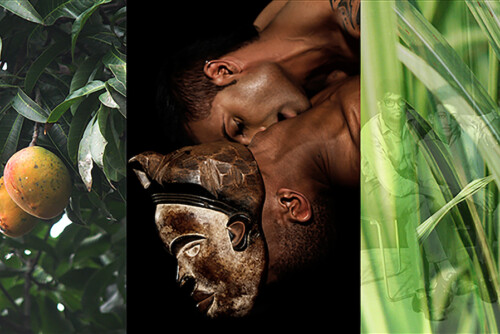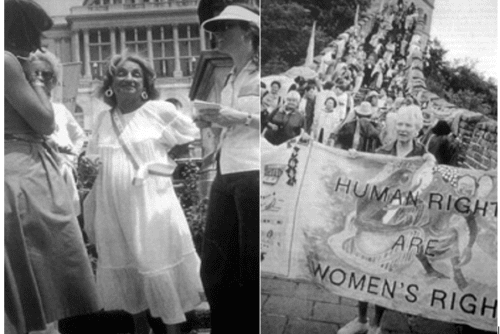A closer look at the roles of the white men in the films uncovers another narrative. Although the young white man at the center of the films should be the one who actively directs the action, in the three films, the young heir of white civilization (the engineer in love with the ward of the Marquis Severo, Jean Gabin as the sailor who ends up in jail, and Max the failed writer) presents an image of white masculinity strangely damaged by overpowering white females, or in Gabin’s case, as Ginette Vincendeau has analyzed, a certain ambivalence.1 In Sirens of the Tropics, the marquis is a lecher. It is his wife who rules over his colonial affairs and who eventually sails to the tropics with her protégée to have her reunited with her fiancé. In Princess Tam Tam, the wife is a devouring female, a “femme émancipée,” or flapper, and the film incorporates a satire of this New Woman of the twenties. She smokes, she flirts, and she drives an automobile.
Max de Mirecourt does not see his work as a novelist as art but rather as a means of showing off in society and proving his talent. Being a writer is a posture, a pose, a social position. This portrayal of Max owes a great deal to vaudeville. When he sits down to write, he flings loose sheets of paper about him, takes off his jacket, puts on his gown and stares at the camera. He is accompanied by an agent, appropriately called “Coton” (cotton), who at one point in the film jokes about being a ghostwriter (un nègre in French). The status of Tahar, the handyman and factotum in the writer’s villa, can also be equated to that of a slave. In a literal embodiment of images of slavery, complete with erotic overtones, Max stops Tahar from flogging Alwina, who has introduced herself illegally onto his property. One often encounters Baker’s function as a figure of transgression in her films. She is a stowaway (Sirens of the Tropics), and a thief and a beggar when begging is forbidden (Princess Tam Tam).2 The initial transgression in her native setting prepares the viewer for her inability to bear the constraints of Western civilization in the scenes of her Parisian life. Indeed, she dances in the sailors’ bar to be free and to be reunited with the people at large, the poor and the popular. The maharajah earlier made the following ominous pronouncement to Max’s wife: “In the Orient, even the most humble has an independence that you do not suspect.”
Princess Tam Tam is the only film out of the three, unlike the silent Sirens of the Tropics and Zou Zou, in which the successful performance of the dancer and the singer is mis en abyme as an illusion, or at least a fiction.3 Max’s writer’s block leads him to invent a story of jealousy and revenge that aids him in reclaiming his wife’s admiration and love. His strategy is successful in so far as he eventually writes a novel entitled Civilization, a book that has fallen off the shelves in his “African” house, now owned by Alwina, Tahar, and their child. He is ultimately portrayed signing autographs for admirers. Max’s pathetic literary attempts can thus be read as modernism’s essential gesture: the rejuvenation of decadent Western culture at the spring of the authentic primitive. As numerous critics have observed, this gesture of revivification found an unexpected literalization in the figure of Baker.4 Baker was African American: she did not put on a mask to create that “identity.” In other words, the stereotype of the primitive black body functioned in the coincidence between the fulfillment of the modernist desire for novelty and the “reality” of her civilian identity.5 In the film, Alwina never actually moves beyond Tunisia; she stays put, at home, reclaiming the colony’s usurped territory in the shape of the villa. The phantasm of revivification appears for what it is: a phantasm, mere narrative fiction. The film could thus be read as a comment on the way in which phantasm, feeding on its representations of the alien other, may leave that other untouched (the “and why not?” quoted earlier from Baker’s Mémoires). Having rekindled his flame for his wife with a fake love affair with a native woman, the writer returns to the vanity of his former life.6
- Claude Gauteur and Ginette Vincendeau, Jean Gabin: Anatomie d’un mythe (Paris: Editions nouveau monde, 2006), pp. 232-239. [↩]
- In Zou Zou, Jean Gabin is the one who ends up in jail. [↩]
- Baker also starred in a fourth film, The French Way (1945). [↩]
- See Petrine Archer-Straw, Negrophilia: Avant-Garde Paris and Black Culture in the 1920s (London: Thames and Hudson, 2000); Sieglinde Lemke, Primitivist Modernism: Black Culture and the Origins of Transatlantic Modernism (New York: Oxford University Press, 1998); Michel Fabre, “International Beacons of African-American Memory: Alexandre Dumas père, Henry O. Tanner and Josephine Baker” in Geneviève Fabre and Robert O’Mealy, eds. History and Memory in African American Culture (New York: 1994), 122-129; Terri Francis, “Embodied Fictions, Melancholy Migrations: Josephine Baker’s Cinematic Celebrity” MFS, Vol. 51, 4, Winter 2005, 824-844. For the more specific literary context, see Bennetta Jules-Rosette, Black Paris: The African Writer’s Landscape (Champaign-Urbana: University of Illinois, 1998); Michel Fabre, From Harlem to Paris: Black American Writers in France 1840-1980 (Champaign-Urbana: University of Illinois Press, 1991). [↩]
- See Homi Bhabha, The Location of Culture (New York: Routledge, 1994). [↩]
- Josephine Baker thought that she should have married the maharajah. She claims that Pepito Abatino is responsible for the ending. Baker is reported as having a love affair with a real maharajah. [↩]




